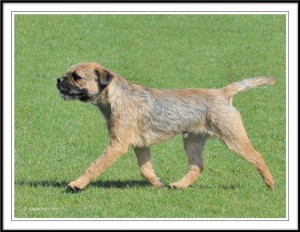Group: Terrier
Size: Small
Lifespan: 12-14 years
Exercise: Moderate
Grooming: Moderate
Trainability: Easy
Watchdog ability: High
Protection ability: Very low
Area of Origin: border of Scotland and England
Date of Origin: 1700’s
Other Names: none
Original Function: Fox bolting, ratting
History of the Breed
The Border Terrier was originally bred in the Cheviot Hills area near the border between England and Scotland to help farmers drive predatory foxes from their dens and kill them. This sturdy little fellow has long enough legs and enough stamina to keep up with a horse, even though he is quite small. The bold little Border Terrier has also been used to hunt marten, otter and the fierce badger. The breed was once known as the Coquetdale Terrier (among other names), but the name Border Terrier, taken from the Border Hunt, was adopted in 1870. As with most terriers, the Border Terrier gradually began to be taken into the home. Today due to his winning personality, adaptability and friendliness, the breed is highly esteemed as a companion dog, yet he can still serve as a fine farm dog, helping to control vermin.
Temperament
Lively and alert but also mild-mannered, the Border Terrier is a loving good natured companion that loves being with its owner. It is generally good with other dogs and cats, but not with rodents. It is very good with children and makes a good companion for people of all ages. It digs, and some bark. Some are talented escape artists.
Upkeep
The Border likes activity and needs a good walk on leash, a vigorous game session or an off-lead expedition in a safe area every day. It can live outdoors in temperate climates, but it does much better when allowed to divide its time between house and yard. The Border Terrier has a weather resistant coat with a hard, wiry outer coat and soft undercoat repels most dirt. Its harsh coat needs brushing weekly, plus stripping of dead hairs about four times yearly to maintain its clean outline.

